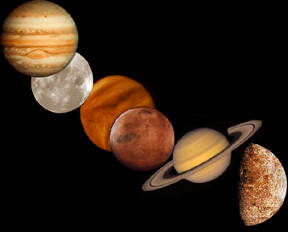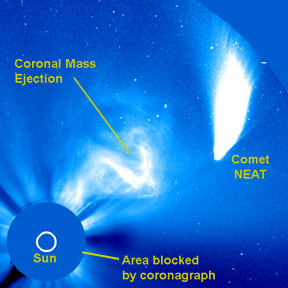SOHO's view of comet NEAT on 18 February 2003.
Click on image for full size
Image courtesy NASA
Comet NEAT passes Sun
News story originally written on February 20, 2003
The picture on this page shows Comet NEAT on February 18, 2003
as it passed very close to the Sun. The comet was too
close to the Sun to be viewed from Earth; the bright light from the Sun blocked our view of the comet.
However, the SOHO spacecraft, which observes the Sun continuously
from an orbit 1.5 million kilometers from Earth, was able to capture images of the comet's close pass by the Sun.
SOHO has an instrument called a coronagraph, which blocks out the
brightest light from the Sun, allowing it a good view of the comet's
closest approach.
Comet NEAT (which is also called Comet C/2002 V1) was discovered in November 2002 by NASA's
Near Earth Asteroid Tracking (NEAT) program, which searches for
asteroids that pass near Earth. This time the NEAT
project found a comet instead of an asteroid, so Comet NEAT was named in honor of the program that found it.
Scientists are interested in observing comets as they pass near the Sun. Since comets are made mostly of ice,
they melt a lot when they pass near the Sun. Scientists are curious about how a comet changes as it melts. The picture
on this page also shows a Coronal Mass Ejection (CME) erupting from the Sun.
A CME is a huge explosion on the Sun. Scientists are curious to see what effect the CME had on the comet.
You might also be interested in:

It was another exciting and frustrating year for the space science program. It seemed that every step forward led to one backwards. Either way, NASA led the way to a great century of discovery. Unfortunately,
...more
The Space Shuttle Discovery lifted off from Kennedy Space Center at 2:19 p.m. EST, October 29th. The sky was clear and the weather was great as Discovery took 8 1/2 minutes to reach orbit for the Unitied
...more
A moon was discovered orbiting the asteroid, Eugenia. This is only the second time in history that a satellite has been seen circling an asteroid. A special mirror allowed scientists to find the moon
...more
Will Russia ever put the service module for the International Space Station in space? NASA officials are demanding an answer from the Russian government. The necessary service module is currently waiting
...more
During a period of about two days in early May, 1998, the ACE spacecraft was immersed in plasma associated with a coronal mass ejection (CME). The SWICS instrument on ACE, which determines unambiguously
...more
J.S. Maini of the Canadian Forest Service has referred to forests as the "heart and lungs of the world." Forests reduce soil erosion, maintain water quality, contribute to atmospheric humidity and cloud
...more
In late April through mid-May 2002, all five naked-eye planets are visible simultaneously in the night sky! This is includes Mercury which is generally very hard to see because of its proximity to the
...more















